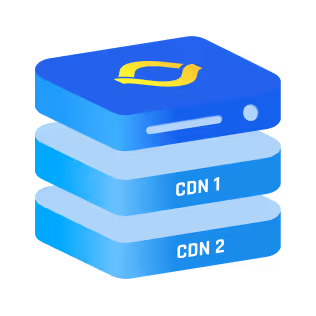The Best 7 Performance Synthetic Testing Tools
Monitor your site proactively with these top 7 synthetic testing tools that simulate user actions to catch issues early.

How do you know your site’s working right now?
Not based on yesterday’s traffic. Not based on a user complaint. Right now.
You’d have to use performance synthetic testing tools. They simulate real user actions—clicks, logins, checkouts—on repeat. Think of them as tireless bots that catch performance issues before your users do.
They don’t wait. Neither should you.
What Is Synthetic Performance Testing?
Synthetic performance testing uses automated scripts to simulate user actions—like visiting pages or submitting forms—under controlled, pre-production conditions.
The goal is to evaluate how your application performs before you release it.
This kind of testing helps you:
- Benchmark application speed
- Catch slowdowns before deployment
- Validate how well your infrastructure scales under load
It’s commonly used in staging or QA environments as part of a release process. While it often uses the same tools as synthetic monitoring, the purpose and timing are different.
{{promo}}
Synthetic Testing vs. Synthetic Monitoring
What Do These Tests Simulate?
Synthetic scripts can replicate:
- Page loads from specific regions
- User flows like logins, checkouts, or signups
- API transactions with expected request/response pairs
- Performance metrics like TTFB, LCP, CLS, or error rates
Most synthetic monitoring software allows you to define these steps using either code-based scripting or low-code visual editors.
The Importance of Synthetic Performance Testing Tools
Real-world traffic is unpredictable. Devices, browsers, networks—all vary. But synthetic tests run in consistent environments, making them perfect for:
- Establishing clean baselines
- Comparing performance across releases
- Isolating backend or third-party slowdowns
This contrasts with real user monitoring, which tracks performance across actual sessions and devices.
While basic uptime checks are common, modern tools also support:
- Real browser tests for web performance
- Multi-step flows like shopping carts or onboarding
- API validations with response time tracking
Each layer brings proactive visibility into problems that real users haven’t even seen yet.
The Best 7 Performance Synthetic Testing Tools
Looking for continuous oversight after deployment? Pair these synthetic performance testing with website monitoring to catch real-time issues the moment they happen.
1. LoadNinja (by SmartBear)
Overview: A cloud-based performance testing tool that runs load tests using real browsers, focusing on accurate end-user simulation without scripting or manual correlation.
LoadNinja is engineered for teams that need high-fidelity performance testing without the typical headaches of scripting, manual correlation, or maintaining test infrastructure. By running tests in real browsers, it provides visibility into client-side rendering issues and true end-user delays—something protocol-based emulators often miss.
The platform shines in pre-production load testing: validating performance baselines, stress testing user journeys, and ensuring APIs and SPAs hold up under pressure.
Its browser-based architecture makes it especially valuable for modern web apps built with frameworks like React, Angular, and HTML5. LoadNinja offers real-time VU inspection, a built-in JavaScript console for debugging, and a machine-learning assistant (Sensei) that helps interpret trends—providing actionable, developer-friendly insights during tests.
2. NeoLoad (by Tricentis)
Overview: An enterprise-grade performance testing platform built for complex applications—web, mobile, APIs, SAP, and more—offering hybrid load generation (protocol and real browser) with scriptless design.
NeoLoad focuses on performance synthetic testing at an enterprise scale—covering everything from microservices and APIs to SAP and Citrix apps. It simulates user behavior under load using protocol-level efficiency and real browser accuracy, making it ideal for end-to-end performance evaluation.
Its scriptless GUI allows quick test creation without coding, while JavaScript and "test as code" options support advanced use cases. Combined with support for dynamic content, automatic correlation, and reusable test assets, it suits both QA engineers and DevOps teams. NeoLoad Web further enhances collaboration by centralizing test management and result sharing.
The platform shines in CI/CD environments and integrates with APM tools for root cause correlation. Real-time dashboards, detailed SLA tracking, and excellent HTML reporting make analysis straightforward.
3. Dynatrace Synthetic Monitoring
Overview: Part of the full-stack Dynatrace observability platform, this synthetic monitoring solution simulates real user behavior via browser and HTTP checks from global or private locations.
Dynatrace Synthetic Monitoring focuses on continuous performance validation, availability monitoring, and diagnostics—not brute-force load generation. Its strength lies in pairing synthetic check data with full-stack APM metrics captured by OneAgent, allowing Davis AI to instantly pinpoint root causes across backend services and infrastructure.
Clickpaths simulate full user journeys across browsers with no scripting needed, while HTTP monitors track API health and SLA compliance. Private ActiveGate deployments allow for internal network testing, and JavaScript can add dynamic behavior to synthetic flows. The platform’s execution limits (e.g., 5000 on-demand monitor runs per minute) enable CI/CD integration for quality gating and regression checks.
With powerful dashboards, waterfall views, and real-time analysis across synthetic and real-user data, Dynatrace excels at detecting subtle performance drifts before they become incidents.
4. Checkly
Overview: Checkly one of the few developer-first synthetic monitoring tools that merges performance validation with automation workflows. It supports browser checks using Playwright, API checks, TCP, and heartbeat monitoring, all defined as code.
Checkly focuses on performance validation: ensuring every endpoint, flow, and API remains functional, fast, and reliable. Tests run at frequent intervals and from global or internal locations, catching issues early.
Browser checks leverage Playwright for rich UI testing, capturing Core Web Vitals and full user journeys. API tests include multistep chains with logic in Node.js. Developers can define, version, and trigger checks as part of their codebase using the Monitoring as Code model, which fits cleanly into GitOps and CI/CD.
Diagnostic power comes from screenshots, HAR logs, Playwright traces, and OpenTelemetry support, giving teams context-rich failures for fast triage.
5. Dynatrace Synthetic Monitoring
Overview: A powerful synthetic monitoring solution built into the Dynatrace observability platform, designed to simulate user journeys and API calls across global and private locations.
You won’t simulate 10K users at once, but you’ll catch regressions, auth errors, and flaky flows long before users do. Synthetic clickpaths cover login flows, form fills, and key transactions. API tests go even deeper with chaining, dynamic token handling, and pre/post-script logic.
What makes Dynatrace especially valuable is context. Davis AI connects the dots, reducing MTTR and turning failed runs into actionable fixes.
If your org is already invested in Dynatrace APM, this synthetic module unlocks massive synergy. The pricing is usage-based ($0.001/request), so teams will need to balance frequency and test volume carefully. Still, for high-value paths and internal SLA enforcement, the observability payoff is huge.
6. k6 by Grafana Labs
Overview: Written in Go with JavaScript scripting, k6 supports HTTP, WebSockets, gRPC, and browser-based tests (via a Chromium-powered module).
k6 is purpose-built for teams that want to bring performance testing into their development pipelines without relying on heavyweight legacy tools.
You write performance tests just like unit tests—in clean JavaScript or TypeScript—define thresholds, and then automate the whole thing inside your CI/CD workflows.
While it began as a protocol-level load testing tool, the addition of browser-level testing through k6/browser expands its scope to frontend UX validation too.
Combine this with strong Grafana dashboard support and you get full visibility into backend, API, and user-facing performance.
7. Catchpoint
Overview: An enterprise Internet Performance Monitoring (IPM) platform with deep synthetic testing capabilities, Catchpoint simulates user interactions from 3000+ global vantage points to measure performance across the entire Internet Stack—from DNS to frontend UX.
Catchpoint is engineered for organizations that need end-to-end visibility into internet performance—whether validating pre-production performance, benchmarking app availability, or diagnosing third-party issues.
Browser testing supports everything from single-page metrics to full transaction flows using Selenium, Playwright, and Puppeteer. API tests handle chained calls, OAuth tokens, and dynamic data. With deep tracing, error capture, and statistical visualization, it becomes a go-to tool for performance engineers needing precise root cause diagnostics.
What makes Catchpoint unique isn’t raw VU load—it’s where and how it runs. Its agents span backbone and last-mile networks, not just cloud regions, helping teams see what users actually experience. The learning curve is real, but so is the power. For enterprise DevOps teams, it’s a synthetic testing powerhouse.
{{promo}}
Key Features of Synthetic Performance Testing Tools
Good performance synthetic transaction monitoring tools are a toolkit built to simulate user behavior and measure how your system responds—before real users are even involved.
Here’s what these tools usually include under the hood:
1. User Journey Simulation
These tools simulate real workflows:
- Load the homepage
- Log in as a user
- Add items to cart and check out
- Fill out forms or call APIs
Some tools use real browsers to run these steps, which lets you measure frontend performance (like LCP or CLS) as users would experience it.
2. Test Execution from Multiple Locations
To catch region-specific slowdowns or CDN issues, synthetic tools:
- Run tests from global checkpoints
- Let you simulate mobile vs desktop access
- Replicate different network conditions (like 3G or broadband)
This shows how your app performs in the real world, not just in your dev environment.
3. Performance Metrics & Reporting
They capture data like:
- Time to First Byte (TTFB)
- Page load speed
- Transaction success/failure rates
- Availability (uptime/downtime)
Better tools also give you waterfall charts, console logs, and detailed error snapshots for debugging.
4. Alerting & Monitoring Hooks
Most tools include:
- Threshold-based alerts (e.g. load time > 3s)
- Re-tests to reduce false positives
- Integration with Slack, PagerDuty, or email
This keeps your team in the loop without flooding them with noise.
5. Script Management & Maintenance
To stay useful long-term, these tools offer:
- No-code or low-code script editors
- Reusable step components
- Smart ways to reduce test breakage when the UI changes
That’s what defines capable synthetic monitoring solutions, those that go beyond uptime and give you real insight into how your product performs across devices, locations, and user flows.
Conclusion
Synthetic performance testing is how you prevent surprises.
Every slowdown, broken API, or checkout failure that hits your users could have been caught. These tools simulate entire journeys across devices, networks, and locations before real traffic hits your servers.
Each tool on this list brings something unique to the table:
- Need load at scale? Go with NeoLoad or k6.
- Want rich browser metrics? Catchpoint and Dynatrace deliver.
- Focused on dev-first workflows? Checkly and LoadNinja shine.
But here’s the real takeaway: the best tool is the one you’ll actually integrate into your release flow.


.png)
.png)
.png)





